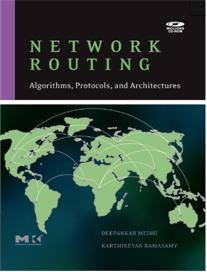| |
|
|
Sample Course Outlines
You can use this book mainly in two different ways.
First, the book is designed to serve as a self-study book for
professionals. You can pick and choose what you want to read. In most
cases, each chapter can be read independently while in some cases
there's dependency on one or more chapters. In fact, each chapter
starts with a short 'reading guideline' so that you can quickly find
out any
dependency on other chapters (and how much).
Second, the book is designed to teach a number of different
courses, either in a classroom or in a professional setting (short
courses). Instructors, who plan to use in a class, may request an examination
copy of the book by registering through
Elsevier's textbook site.
Graduate course outlines shown below assume that students
already have an introductory course on networking.
Below, we give some sample course
organizations for semester-long courses.
Internet Routing (Undergraduate course)
Cover the following topics at a slower pace:
Chapter 1: Networking and Network Routing: An Introduction
Chapter 5: IP Routing and Distance Vector Protocol Family
(along with Section 3.3)
Chapter 6: OSPF and Integrated IS-IS (along with Section 3.4)
Chapter 9: Internet Routing Architectures
Chapter 14: Router Architectures
(time permitting, parts of Chapter 8: BGP)
Routing Survey (Undergraduate level)
Chapter 1: Networking and Network Routing: An Introduction
Chapter 5: IP Routing and Distance Vector Protocol Family
(along with Section 3.3)
Chapter 6: OSPF and Integrated IS-IS (along with Section 3.4)
Chapter 9: Internet Routing Architectures
Chapter 12: SS7: Signaling Network for Telephony
Chapter 13: Public Switched Telephone Network: Architecture and Routing
Chapter 20: VoIP Routing: Interoperability Through IP and PSTN
Internet Routing (Graduate course)
Chapter 1: Networking and Network Routing: An Introduction
Chapter 2: Routing Algorithms: Shortest Path and Widest Path
Chapter 3: Routing Protocols: Framework and Principles
Chapter 5: IP Routing and Distance Vector Protocol Family
Chapter 6: OSPF and Integrated IS-IS
Chapter 8: BGP
Chapter 9: Internet Routing Architectures
Chapter 14: Router Architectures
Chapter 15: IP Address Lookup Algorithms(part of the chapter)
Chapter 18: MPLS and GMPLS
Internet Routing (Graduate course, with traffic engineering emphasis)
Chapter 1: Networking and Network Routing: An Introduction
Chapter 2: Routing Algorithms: Shortest Path and Widest Path
Chapter 4: Network Flow Modeling
Chapter 6: OSPF and Integrated IS-IS
Chapter 7: IP Traffic Engineering
Chapter 8: BGP
Chapter 9: Internet Routing Architectures
Chapter 18: MPLS and GMPLS
Chapter 19: Routing and Traffic Engineering with MPLS
Routers and Switches: Design and Implementation (Graduate course)
Chapter 1: Networking and Network Routing: An Introduction
Chapter 9: Internet Routing Architectures
Chapter 14: Router Architectures
Chapter 15: IP Address Lookup Algorithms
Chapter 16: IP Packet Filtering and Classification
Chapter 21: Switching Packets
Chapter 22: Packet Queueing and Scheduling
Chapter 23: Traffic Conditioning
Network Routing (Graduate course)
Chapter 1: Networking and Network Routing: An Introduction
Chapter 2: Routing Algorithms: Shortest Path and Widest Path
Chapter 6: OSPF and Integrated IS-IS
Chapter 8: BGP
Chapter 9: Internet Routing Architectures
Chapter 10: Hierarchical and Dynamic Call Routing in the Telephone Network
Chapter 13: Public Switched Telephone Network: Architecture and Routing
Chapter 17: Quality of Service Routing
Chapter 18: MPLS and GMPLS
Chapter 20: VoIP Routing: Interoperability Through IP and PSTN
Chapter 24: Transport Network Routing
Chapter 25: Optical Network Routing and Multilayer Routing
PSTN and transport routing (Graduate course)
Chapter 10: Hierarchical and Dynamic Call Routing in the Telephone Network
Chapter 11: Traffic Engineering in the Voice Telephone Network
Chapter 12: SS7: Signaling Network for Telephony
Chapter 13: Public Switched Telephone Network: Architecture and Routing
Chapter 17: Quality of Service Routing
Chapter 24: Transport Network Routing
Chapter 18: MPLS and GMPLS
Chapter 19: Routing and Traffic Engineering with MPLS
Chapter 25: Optical Network Routing and Multilayer Routing
Routing and Traffic Engineering (Graduate course)
Chapter 1: Networking and Network Routing: An Introduction
Chapter 2: Routing Algorithms: Shortest Path and Widest Path
Chapter 4: Network Flow Modeling
Chapter 6: OSPF and Integrated IS-IS
Chapter 7: IP Traffic Engineering
Chapter 10: Hierarchical and Dynamic Call Routing in the Telephone Network
Chapter 11: Traffic Engineering in the Voice Telephone Network
Chapter 17: Quality of Service Routing
Chapter 18: MPLS and GMPLS
Chapter 19: Routing and Traffic Engineering with MPLS
Chapter 24: Transport Network Routing
Chapter 25: Optical Network Routing and Multilayer Routing
Comprehensive Routing course (Graduate level): two semester long
-- pretty much the entire book by appropriately splitting chapters over the two semesters
(for example, Internet Routing, and Router Design)
Finally, if you've other ideas, especially from trying out, please let
us know; we'll post it here.
|

